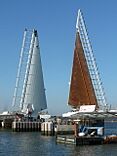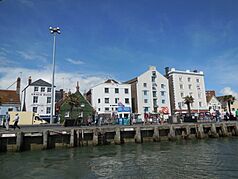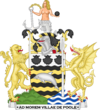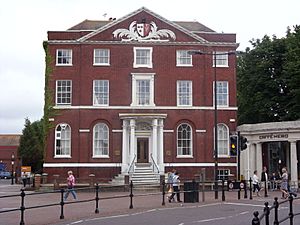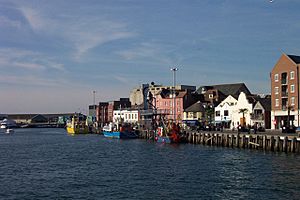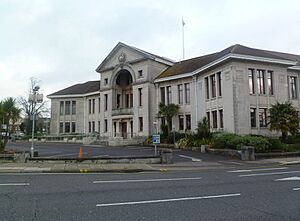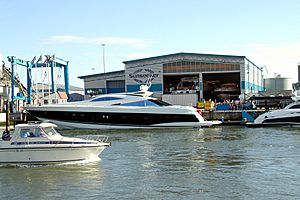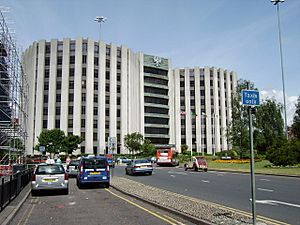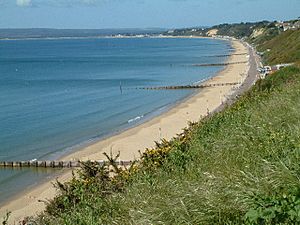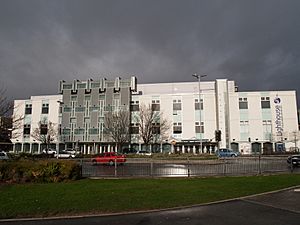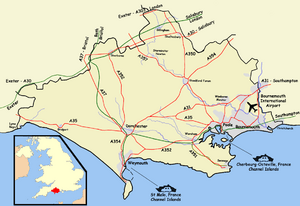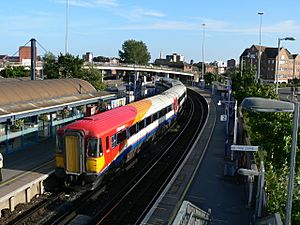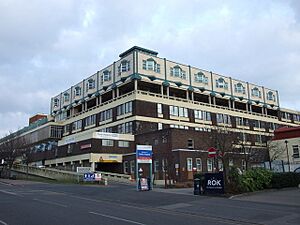Poole facts for kids
Quick facts for kids
Poole
|
|||
|---|---|---|---|
|
Twin Sails Bridge, Parish church, Hamworthy Bridge, the Old Town, the Quayside
|
|||
|
|||
| Motto(s):
"Ad Morem Villae De Poole" "According to the custom of the Town of Poole"
|
|||
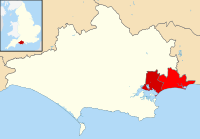
Former Poole unitary authority (dark red) within Bournemouth, Christchurch and Poole (red)
|
|||
| Sovereign state | United Kingdom | ||
| Constituent country | England | ||
| Region | South West England | ||
| Ceremonial county | Dorset | ||
| Historic county | Dorset | ||
| Unitary authority | Bournemouth, Christchurch and Poole | ||
| Government | |||
| • Type | Charter trustee | ||
| • Body | Bournemouth, Christchurch and Poole Council | ||
| Area | |||
| • Total | 25.05 sq mi (64.88 km2) | ||
| Population
(2005 est.)
|
|||
| • Total | 151,500 | ||
| • Density | 5,520/sq mi (2,133/km2) | ||
| Time zone | UTC0 (Greenwich Mean Time) | ||
| Postcodes |
BH12–17
|
||
| Area code(s) | 01202 | ||
| ISO 3166-2 | GB-POL | ||
| ONS code | 00HP (ONS) E06000029 (GSS) |
||
| OS grid reference | SZ009906 | ||
| Ethnicity 2011 Census |
91.9% White British 3.3% Other White 1.0% South Asian 0.3% Black 3.5% Other |
||
Poole is a town and seaport located on the south coast of England. It is part of the Bournemouth, Christchurch and Poole area in Dorset. The town is about 21 miles (34 km) east of Dorchester and is right next to Bournemouth to the east.
Since April 1, 2019, the local government for Poole has been the Bournemouth, Christchurch and Poole Council. In mid-2016, Poole had an estimated population of 151,500 people. This makes it the second-largest town in the ceremonial county of Dorset. When combined with Bournemouth and Christchurch, the total population of this larger urban area is nearly 400,000.
Poole has been settled since before the Iron Age. Its name was first recorded in the 12th century. The town became an important port, especially thriving with the wool trade. Later, it had strong trade connections with North America. In the 18th century, Poole was one of Britain's busiest ports. During the Second World War, Poole was a key starting point for the Normandy landings.
Today, Poole is a popular place for tourists. People visit for its large natural harbour, interesting history, the Lighthouse arts centre, and its beautiful Blue Flag beaches. The town also has a commercial port. From here, ferries carry goods and passengers across the English Channel. These ferries connect Poole with the Channel Islands (like Jersey and Guernsey) and the French town of Saint-Malo in Brittany.
The main office of the Royal National Lifeboat Institution (RNLI) is in Poole. The Royal Marines also have a base in the town's harbour. Even though they have "Bournemouth" in their names, The Arts University Bournemouth, the Bournemouth Symphony Orchestra, and a big part of Bournemouth University are actually located in Poole.
Contents
- History of Poole
- Local Government in Poole
- Poole's Coat of Arms
- Geography and Natural Environment
- People and Population
- Poole's Economy
- Famous Places in Poole
- Places of Worship
- Sports and Fun Activities
- Culture and Events
- Getting Around Poole
- Education in Poole
- Public Services
- Media in Poole
- Famous People from Poole
- Twin Town
- Images for kids
- See also
History of Poole
The area around Poole has been lived in for at least 2,500 years. Evidence of human activity goes back to the Neolithic period at Hengistbury Head. Around 300 BC, Celtic-speaking people called the Durotriges moved to the heathland near the River Frome and Poole Harbour. The Romans arrived in Poole during their conquest of Britain in the 1st century. They took over an Iron Age settlement at Hamworthy, which is just west of the modern town centre. This place was used to supply their forts nearby.
The town's name likely comes from old words meaning a "pool" or "creek." This name probably started around the time after the Romans or during the Anglo-Saxon period.
During the Anglo-Saxon period, Poole was part of the Kingdom of Wessex. It was a fishing base and a safe place for ships to stop on their way to Wareham. Poole faced two big Viking attacks. In 876, Guthrum sailed his fleet through the harbour to attack Wareham. In 1015, Canute started his conquest of England from Poole Harbour.
After the Norman conquest of England, Poole quickly grew into a busy port. This happened as the importance of Wareham declined. The first written mention of Poole was in 1196. It described the new St James's Chapel in "La Pole." In 1248, the Lord of the Manor, Sir William Longspée, sold a charter (a document granting rights) to the people of Poole. This helped him raise money for a Seventh Crusade.
Because of this charter, Poole gained some freedom from feudal rule. It also got the right to choose a mayor and hold a court. In 1433, Poole's growing importance was recognized. King Henry VI made it a staple port. This meant it could export wool, and it was allowed to build a town wall. In 1568, Poole became even more independent. Elizabeth I made it a county corporate. This meant it was legally separate from Dorset.
During the English Civil War, Poole supported Parliament. This was because of its puritan beliefs and merchants who opposed King Charles I's taxes. Poole avoided major attacks. In 1646, the Parliamentary soldiers from Poole helped capture the Royalist stronghold at Corfe Castle.
In the 16th century, Poole started successful trade with the North American colonies. This included the important fisheries of Newfoundland. This trade grew to meet the demand for fish in Europe. Poole's most successful period for this trade was from the early 18th century to the early 19th century. Ships would sail to Newfoundland with salt, then carry dried fish to Europe. They would return to Poole with wine and olive oil.
By the early 1700s, Poole had more ships trading with North America than any other English port. This brought great wealth to Poole's merchants. This wealth helped build many of the Georgian mansions and terraced houses you see in the Old Town today. After the Napoleonic Wars and the War of 1812, Britain lost its special control over the Newfoundland fisheries. Other countries could offer services cheaper. Poole's trade with Newfoundland quickly declined, and most merchants stopped trading within ten years.
Poole grew fast during the Industrial Revolution. More people moved to towns, and Poole became a place of both wealth and poverty. At the start of the 1800s, most workers were involved in harbour activities. But as the century went on, ships became too big for Poole's shallow harbour. The port lost business to deeper ports like Liverpool and Southampton. Poole's first railway station opened in Hamworthy in 1847. It was later extended to the centre of Poole in 1872. This largely ended the port's busy coastal shipping trade.
In the 19th century, the beaches and scenery of Dorset started to attract tourists. Villages east of Poole grew and merged, forming the seaside resort of Bournemouth. While Poole didn't become a resort itself, it continued to do well. Bournemouth's fast growth created a big demand for goods made in Poole.
During World War II, Poole was the third-largest starting point for the D-Day landings of Operation Overlord. After D-Day, it was a base for supplies to the allied forces in Europe. Eighty-one landing craft carrying American troops left Poole Harbour for Omaha Beach. Poole was also important for developing Combined Operations. It was a base for 60 US Coast Guard rescue boats.
Much of the town was bombed by Germany during the war. 75 civilians lost their lives. After the war, years of neglect followed. Major redevelopment projects started in the 1950s and 1960s. Many old, poor-quality buildings were torn down and replaced with modern housing and facilities. Sadly, many of Poole's historic buildings were also demolished. To protect the remaining important buildings, a 6-hectare (15-acre) Conservation Area was created in the town centre in 1975. The Poole explosion of 1988 caused 3,500 people to leave the town centre. This was the biggest peacetime evacuation in the country since World War II.
Local Government in Poole
Poole has one level of local government. This is the unitary authority called Bournemouth, Christchurch and Poole Council. Its main office is at the Civic Centre in Bournemouth.
How Poole's Government Changed Over Time
Poole was an old town with its own government. It got its first special document, called a charter, in 1248. This was from William Longespée the Younger, who owned the land. In 1538, Poole became its own parish, separate from Canford Magna.
In 1568, Poole was given the right to choose its own sheriff. This made it a county corporate, meaning it was independent from the county of Dorset.
In 1836, Poole's government was updated to become a municipal borough. Its borders were made larger to include Hamworthy, Longfleet, and Parkstone.
When elected county councils started in 1889, Poole was not big enough to have its own county council. So, it became part of the administrative county of Dorset. The town's borders grew again in 1905 to include Branksome, and in 1931 to include Canford Magna. In 1932, the town council built the Poole Civic Centre to be its new headquarters.
In 1974, Poole's local government changed again. It became a non-metropolitan district under the Local Government Act 1972. It kept the same borders and its "borough status."
In 1997, Poole Borough Council became a unitary authority. This meant it took over all the responsibilities that the Dorset County Council used to have for Poole.
The borough of Poole stopped existing in 2019. It joined with Bournemouth and Christchurch to form a new local government area. This new area is called Bournemouth, Christchurch and Poole. This new council is also a unitary authority. The Bournemouth, Christchurch and Poole area is still part of the ceremonial county of Dorset.
Since 2019, Poole has had "charter trustees." These are the local councillors who represent the areas that used to be part of Poole. They help keep the town's old traditions alive. This includes choosing a mayor and a sheriff each year. These roles are now mostly honorary. Poole is one of only fifteen towns in England and Wales that still chooses its own sheriff.
Poole's Representatives in Parliament
Poole is represented by three Members of Parliament (MPs) in the House of Commons. These MPs represent the areas of Poole, Mid Dorset and North Poole, and Bournemouth West. The Poole constituency has existed since 1950. Before that, the town had elected MPs since 1455.
Poole's Coat of Arms
The design of Poole's coat of arms comes from an old seal from the late 1300s. The wavy black and gold lines represent the sea. The dolphin shows Poole's connection to the sea. The scallop shells are a symbol of Saint James. They are linked to his shrine at Santiago de Compostela. This was a popular place for Christian pilgrims who left from Poole Harbour long ago.
The coat of arms was officially confirmed in 1948. At the same time, a crest was added. This crest shows a mermaid holding an anchor and a cannonball. In 1976, the council also received "supporters" for the coat of arms. These are figures on either side of the shield. The gold lion on the left represents William II Longespée. He granted Poole its first charter in 1248. The dragon on the right comes from the Royal Arms of Elizabeth I. She made Poole a county corporate in 1568.
The Latin motto – Ad Morem Villae De Poole – means: According to the Custom of the Town of Poole. This motto comes from the Great Charter of 1568.
Geography and Natural Environment
Poole is located on the northern and eastern edges of Poole Harbour. This is about 97 miles (156 km) west-southwest of London. The oldest part of town, including the historic Old Town and Poole Quay, sits on a piece of land sticking out into the harbour. Much of the land to the east has been created from the harbour since the mid-1900s.
To the west of Poole are Upton and Corfe Mullen. Across the northern border, at the River Stour, is Wimborne Minster. On Poole's eastern side, the town meets Bournemouth and areas like Kinson and Parkstone. To the south, along the coast, is Poole Bay. This bay has 3 miles (5 km) of sandy beaches, stretching from Sandbanks in the west to Bournemouth in the east.
Areas and Neighbourhoods of Poole Poole is made up of many suburbs and neighbourhoods. Many of these were once small villages that became part of Poole as the town grew. Some of these areas include:
- Alderney
- Branksome
- Canford Cliffs
- Canford Heath
- Hamworthy
- Lilliput
- Longfleet
- Oakdale
- Parkstone
- Sandbanks
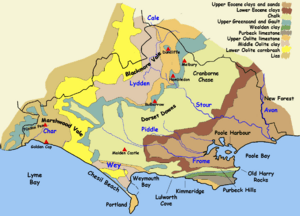
Poole's natural environment features lowland heathland to the north. To the south, there are wooded chines (steep valleys) and coastline. The heathland is home to all six native British reptile species. It also supports many dragonflies and rare birds. Much of the heath has been lost to development. However, remaining parts to the north of Poole are protected areas. The town sits on soft layers of Eocene clays, sands, and gravels. The River Frome flows through this soft rock. Its many smaller rivers have carved out a wide estuary. At the mouth of the estuary, sand has built up, creating sand spits that enclose the estuary to form Poole Harbour.
Poole Harbour is the largest natural harbour in Europe. It is the second-largest natural harbour in the world after Sydney Harbour. It is very important for nature conservation. The harbour is known for its ecology, including salt marshes and mudflats. It is also a vital habitat for many migrating birds. It has been named a Site of Special Scientific Interest (SSSI), a Special Protection Area, and a Ramsar site. It is also part of the Dorset National Landscape area. The harbour covers about 15 square miles (39 km²) and is very shallow. The main shipping channels are 7.5 metres (25 ft) deep. However, the average depth of the harbour is only 48 centimetres (1.6 ft).
The harbour has several small islands. The largest is Brownsea Island. This island is a nature reserve owned by the National Trust. It is also famous as the birthplace of the Scouting movement. The first Scout Camp was held there. Britain's largest onshore oil field operates from Wytch Farm on the harbour's south shore. The oil reservoirs extend under the harbour and eastwards from Sandbanks for 10 km (6 mi) under the sea.
Poole is located just east of the Jurassic Coast. This is a UNESCO World Heritage Site. It includes 153 km (95 mi) of the Dorset and east Devon coast. This area is important for its geology, landforms, and many fossils. The South West Coast Path is England's longest national trail. It stretches for 630 miles (1,010 km) from Minehead to Poole.
Poole's Climate
Poole has a mild climate because it is on the south coast of England. Temperatures do not change much between day and night or throughout the year. The average yearly temperature from 1971 to 2000 was 10.2 to 12°C (50.4 to 53.6°F). July and August are the warmest months, with temperatures usually between 12 and 22°C (54 and 72°F). January and February are the coolest, with temperatures from 2 to 8.3°C (36 to 47°F).
The average sea temperature ranges from 6.9°C (44.4°F) in February to 18.5°C (65.3°F) in August. Poole's average yearly rainfall is 592.6 mm (23.33 in). This is much lower than the UK average of 1,126 mm (44.3 in).
| Climate data for Poole, Dorset, England | |||||||||||||
|---|---|---|---|---|---|---|---|---|---|---|---|---|---|
| Month | Jan | Feb | Mar | Apr | May | Jun | Jul | Aug | Sep | Oct | Nov | Dec | Year |
| Mean daily maximum °C (°F) | 8 (46) |
8 (46) |
11 (52) |
13 (55) |
17 (63) |
19 (66) |
22 (72) |
22 (72) |
19 (66) |
15 (59) |
11 (52) |
9 (48) |
14.5 (58.1) |
| Mean daily minimum °C (°F) | 2 (36) |
2 (36) |
3 (37) |
4 (39) |
7 (45) |
10 (50) |
12 (54) |
12 (54) |
10 (50) |
7 (45) |
4 (39) |
3 (37) |
6.3 (43.3) |
| Average precipitation mm (inches) | 62.9 (2.48) |
50.3 (1.98) |
40.7 (1.60) |
45.5 (1.79) |
29.2 (1.15) |
35.6 (1.40) |
31.8 (1.25) |
35.5 (1.40) |
51.5 (2.03) |
73.5 (2.89) |
69.0 (2.72) |
67.2 (2.65) |
592.6 (23.33) |
| Source: MSN | |||||||||||||
Green Spaces in Poole
Poole is at the centre of a "green belt" area. This green belt helps stop towns from growing too much and merging together. It also protects the countryside and keeps the unique feel of smaller communities. This is done by limiting new buildings in these protected areas.
Poole has green belt areas to its north and west. These areas include rivers, floodplains, and nature reserves. They also include Upton Country Park and the miniature railway. These green spaces help keep the area around Poole natural and beautiful.
People and Population
| Religion | % |
|---|---|
| Buddhist | 0.16 |
| Christian | 74.34 |
| Hindu | 0.15 |
| Jewish | 0.32 |
| Muslim | 0.41 |
| No religion | 16.23 |
| Other | 0.32 |
| Sikh | 0.03 |
| Not stated | 8.03 |
| Age | Percentage |
|---|---|
| 0–4 | 5.2 |
| 5–14 | 12.2 |
| 15–29 | 16.0 |
| 30–44 | 21.5 |
| 45–64 | 24.8 |
| 65+ | 20.3 |
Poole is part of the South East Dorset conurbation. This larger urban area has a total population of over 465,000 people. In the 2011 census, the population of Poole was 147,645. This was an increase from 138,288 in 2001. The town covers about 65 km² (25 sq mi). This means there are about 2,133 people per km² (5,532 per sq mi) living in 60,512 homes.
Poole's population has grown steadily since the 1960s. Most of this growth is due to people moving into the town, often for retirement. The number of homes has more than doubled in the last 40 years. It went from 30,000 in 1961 to about 62,700 in 2004. Compared to the rest of England and Wales, Poole has more residents over 65 (20.3%). However, this is less than the Dorset average of 22.2%. The largest group of people (24.8%) are between 45 and 64 years old.
Most people in Poole are of White British background (95.98%). This is higher than the average for England (86.99%). Other ethnic groups make up 4.0% of Poole's population. The main religion in Poole is Christianity, with almost 74.34% of residents. This is slightly above the UK average. The next largest group (16.23%) has no religion, which is also above the UK average.
House prices in Poole are high compared to the rest of the UK. In 2008, the average house price was £274,011. Detached houses were more expensive at £374,150. Apartments or flats cost around £216,097, which was more than anywhere else in Dorset. House prices in Poole are especially high in Sandbanks. In 2000, Sandbanks had some of the most expensive house prices in the world. A study in 2006 said that Poole was the most expensive town to live in the UK.
| Population growth in Poole since 1801 | |||||||||||||||||||||
|---|---|---|---|---|---|---|---|---|---|---|---|---|---|---|---|---|---|---|---|---|---|
| Year | 1801 | 1811 | 1821 | 1831 | 1841 | 1851 | 1861 | 1871 | 1881 | 1891 | 1901 | 1911 | 1921 | 1931 | 1941 | 1951 | 1961 | 1971 | 1981 | 1991 | 2001 |
| Population | 6,682 | 6,752 | 9,021 | 9,401 | 9,901 | 10,595 | 12,152 | 13,710 | 15,267 | 20,446 | 29,068 | 41,344 | 50,024 | 60,527 | 71,089 | 83,494 | 94,598 | 107,204 | 117,133 | 135,066 | 138,299 |
| % change | – | +1.1 | +33.6 | +4.2 | +5.3 | +7 | +14.7 | +12.8 | +11.4 | +33.9 | +42.2 | +42.2 | +30 | +30 | +17.5 | +17.5 | +13.3 | +13.3 | +9.3 | +15.3 | +2.4 |
| Source: A Vision of Britain through Time |
|||||||||||||||||||||
Poole's Economy
| Poole's employment structure | |||
|---|---|---|---|
| Sector | Poole | Dorset | Great Britain |
| Agriculture | 0.1% | 0.4% | 0.9% |
| Energy and Water | 1.1% | 0.6% | 0.8% |
| Manufacturing | 16.8% | 13.4% | 13.4% |
| Construction | 3.3% | 4.0% | 4.5% |
| Services | 78.7% | 81.7% | 80.5% |
Poole's economy is more balanced than the rest of Dorset. In the 1960s, its wealth grew because of the manufacturing sector. In the 1980s and 1990s, the service sector expanded as office-based companies moved to the area. Manufacturing is less important now than in the 1960s. However, it still employed about 17% of workers in 2002. This is more than the average for Great Britain.
Sunseeker, the world's largest privately owned builder of motor yachts, is based in Poole. It is also the UK's largest manufacturer and employs over 1,800 people in its Poole shipyards. Other big manufacturing companies in Poole include Lush, Siemens, and Ryvita. Poole has the most industrial estates in South East Dorset. These include Nuffield Industrial estate and Mannings Heath.
The service sector is the main part of Poole's economy. Many people work in services for residents or tourists. In the 1970s, Poole's relaxed planning rules attracted businesses from London. These included banks and financial companies like Barclays Bank and American Express Bank. Other important service employers include the main office and college of the Royal National Lifeboat Institution (RNLI). Also, the UK headquarters of Fitness First, Bournemouth University, and Arts University Bournemouth are here. Poole is also home to the clothing company Animal, cosmetics maker Lush, and Merlin Entertainments. Merlin Entertainments is the world's second-largest theme park operator after Disney.
The Dolphin Shopping Centre is Poole's main shopping area. It is the largest indoor shopping centre in Dorset. It opened in 1969 and has been updated several times. The centre has 47,000 m² (510,000 sq ft) of shops with 110 stores. It also has two multi-storey car parks with 1,400 parking spaces. A street with shops, bars, and restaurants connects the Dolphin Centre to the historic Old Town and Poole Quay. Tourism is very important to Poole's economy. In 2002, it was worth an estimated £158 million. Poole's Harbour, Quay, and beaches are major attractions for visitors. There are hotels, guest houses, and bed and breakfast rooms around the town, especially in Sandbanks.
Poole is served by the Port of Poole. Since the 1970s, Poole has become one of Britain's busiest ports. New facilities and deeper shipping channels have allowed a lot of growth in freight and passenger traffic across the English Channel. The port receives large imports like steel, timber, and grain. It exports clay, sand, and grain. Commercial ferry companies run regular passenger and freight services from Poole to Cherbourg, St Malo, and the Channel Islands.
The Royal Marines have a base in the harbour at RM Poole, set up in Hamworthy in 1954. This base is home to the special forces unit, the Special Boat Service. In 2008, 105 fishing boats were registered to the port. This makes it one of the largest registered fishing fleets in the UK. However, the number of boats is slowly going down due to rising fuel costs and fishing limits. Many unlicensed boats also offer fishing trips.
Famous Places in Poole
Poole Quay is a popular place to visit. It is south of the town centre. It has old pubs and historic buildings mixed with new bars and apartments. The Quay used to be the busy heart of Poole's sea industry. All port activities moved to Hamworthy in the 1970s as the Quay became more popular with tourists. The historic Customs House on the quay was built in 1814. It is now a restaurant and bar.
Nearby is the Town Cellars, a medieval warehouse from the 15th century. It now houses a local history centre. Scaplen's Court, another historic building, also dates from the medieval period. Poole Pottery has been redeveloped into an apartment block. Boats regularly leave the quay in summer for cruises around the harbour and to Brownsea Island. Public artworks along the Quay include Sea Music, a large metal sculpture. There is also a life-size bronze sculpture of Robert Baden-Powell. This celebrates the start of the Scout Movement on Brownsea Island. At the west end of the quay is Poole Bridge, built in 1927.
Poole Guildhall has played many roles in the town's history. This historic building was built in 1761. It cost £2,250. The ground floor had an open market house. The first floor had a courtroom and offices for the town council. It was also used as a court for various legal cases. Between 1819 and 1821, the building was used as a parish church. This was while the old St. James Church was being rebuilt.
During the Second World War, the Guildhall was a canteen and meeting room for American soldiers. This was before the invasion of France. The showers installed then were later turned into public baths. These were used until the 1960s. The building became the town museum from 1971 to 1991. It was empty for 16 years after that. After a renovation, the Guildhall reopened in June 2007. It is now a Register Office for weddings and other ceremonies.
Poole has several urban parks. The largest is Poole Park, next to Poole Harbour and the town centre. It opened in 1890 and is a Victorian park. It was made a Conservation Area in 1995 and got a Green Flag in 2008. The park covers 44.3 hectares (109 acres). This includes a human-made lake and ponds covering 24 hectares (59 acres).
The park has two children's play areas, a miniature railway, tennis courts, and a bowling green. There is also a miniature golf course, an Italian restaurant, and an indoor ice rink for children. A cricket field is home to Poole Town Cricket Club. Water sports like sailing and windsurfing happen on the large lake. A war memorial stands in the park. It remembers Poole citizens who died in the First and Second World Wars. The park also hosts several road races.
Poole's sandy beaches are a popular tourist spot. They stretch for 3 miles (5 km) along Poole Bay. The beaches are divided into four areas: Sandbanks, Shore Road, Canford Cliffs Chine, and Branksome Chine. Poole's beaches have won the European Blue Flag for cleanliness and safety 21 times since 1987. This is more than any other British seaside resort. In 2000, a survey rated Poole's beaches among the top five in the country. Along the seafront, there are cafes, restaurants, beach huts, and water-sports facilities. Royal National Lifeboat Institution lifeguards patrol the coast in summer.
Places of Worship
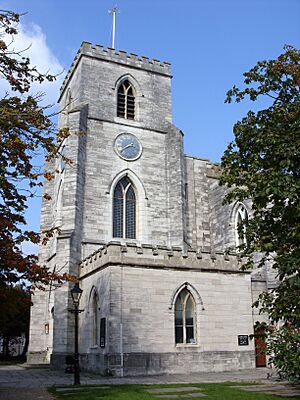
Poole is part of the Church of England Diocese of Salisbury and the Roman Catholic Diocese of Plymouth. Poole has many Christian worship sites. These include five Grade II* and five Grade II listed churches. The Grade II* St James' Church in the Old Town was rebuilt in 1820. The original church on this site was first mentioned in 1142. It had been rebuilt in the 16th century, but in 1819, it was found to be unsafe.
The United Reformed Church hall in the town centre is also a Grade II* building. It was built in 1777. Other Grade II* churches include St. Peter's Parish Church in Parkstone, built in 1876. Also, St Dunstan of Canterbury Orthodox Church in Parkstone, which is an Antiochian Orthodox church. And the Parish Church of St. Aldhelm in Branksome, built in 1892. The Gothic Revival church of St Mary's in Longfleet, built in 1833, is one of Poole's Grade II listed churches. There are also two Christadelphian meeting halls in the town.
Sports and Fun Activities
Poole Harbour and Poole Bay are great places for fun activities. These include sailing, windsurfing, surfing, kitesurfing, and water skiing. The harbour's calm waters attract windsurfers, especially around the northern and eastern shores. Water skiing happens in a special area of the harbour called the Wareham Channel. The waters around the harbour, Poole Bay, and Studland Bay are also popular for fishing and diving.
The beaches at Sandbanks are often used for sports events. These include the Sandbanks Beach Volleyball Festival and the yearly British Beach polo Championship.
Since 1999, Poole's Rossmore Leisure Centre has hosted the GMPD Poole Gymnastics Competition every October. Hundreds of gymnasts from across the country compete each year. The competition celebrated its 20th anniversary in 2019. After a break due to the COVID-19 pandemic, it returned in 2022.
Sailing in Poole
Poole Harbour is one of the biggest centres for sailing in the UK. It has several yacht clubs. These include the East Dorset Sailing Club and Parkstone Yacht Club.
Parkstone Yacht Club has hosted big sailing events. These include the OK Dinghy World Championships in 2004. They also hosted the J/24 National Championships in 2006 and the J/24 European Championships in 2007. The 2020 J24 Worlds were also held there. The club organizes Youth Week and Poole Week. These are two of the largest yearly dinghy regattas in the country.
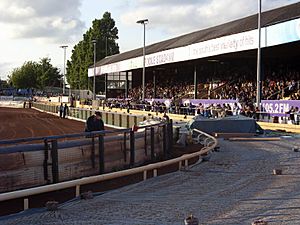
Football Teams
Poole's oldest football team is Poole Town F.C.. They are a semi-professional team that plays in the Southern Football League. This is the seventh level of the English football league system. The team started in 1880. They have had mixed success and have never played above non-League levels. However, they once reached the third round of the FA Cup. They played at Poole Stadium until 1994. Since then, they have played at Tatnam Farm. Poole's other football teams are Hamworthy United and the amateur team Poole Borough F.C. Poole is one of the largest towns in England without a professional football team.
Speedway Racing
Poole's motorcycle speedway team is the Poole Pirates. They started racing at Poole Stadium in 1948. The team now races in the top league, the Elite League. They won this league in 2008, 2011, 2013, and 2014. Poole Stadium also hosts greyhound racing three days a week.
Scouting in Poole
Poole has three of the oldest Scout Association groups in the world. The 1st Parkstone Air Scout Group has records from February 1908. The 1st Hamworthy Scout Group has records from October 1908. Both groups started from old Boys' Brigade units. Members of these units took part in the first Scout Camp in 1907. The Broadstone Group has records from December 1908. It was home to the first King's/Queen's Scout.
Nature Parks and Walking Trails
Poole Council works with the Dorset Wildlife Trust to manage nature parks.
- Holes Bay Nature Park opened in 2015. It includes Upton Country Park. The bay is an important place for wetland birds to feed and rest.
- Corfe Barrows Nature Park opened in 2016. It is a group of eight natural sites. These are managed together for wildlife and people in the north of Poole.
Poole Tourism has created several walking trails. These are called the Poole Harbour Trails.
Cycling Routes
Poole has over 50 miles (80 km) of cycle paths. These include the Castleman Trailway, the Poole Heritage Cycle Route, and the Bourne Valley Greenway.
Culture and Events
The 'Beating of the bounds' is an old yearly tradition. It started in 1612. It involves checking the sea boundaries that were given to Poole in 1364. The Mayor of Poole and other important people sail from the River Frome to Old Harry Rocks. They confirm the mayor's authority over the harbour's water boundaries. In the past, children were encouraged to remember the boundaries by a special ceremony. Today, these acts are done symbolically.
Poole's Summertime in the South is a yearly program. It offers various events on Poole Quay and Sandbanks from May to September. In June and July, there is live music, street entertainment, and fireworks on Poole Quay every Thursday evening. In August, the fun moves to the beaches at Sandbanks.
Poole's Lighthouse is an arts centre. It was built in 1978. It has a cinema, concert hall, studio, theatre, and galleries. These galleries show modern photography and digital art. The centre was renovated in 2002. The Bournemouth Symphony Orchestra has performed its main concerts here since 1985.
Poole Museum is in the Old Town. It tells the story of the area and its people. The museum's collections show Poole's cultural, social, and industrial history. Displays include the Poole Logboat and a detailed history of Poole from the Iron Age to today. One floor is about the history of Poole Pottery. Entrance to the museum is free. Poole Museum is currently closed for updates until about Spring 2025.
Getting Around Poole
Roads in Poole
The A350 road is the main road into Poole town centre. It runs north along Holes Bay to the A35. It continues as a single carriageway to Bath and Bristol. You can also get to the M4 motorway via the A34 at Newbury. To the east, the A337 road leads to Lymington and the New Forest.
The A35 trunk road goes from Devon to Southampton. It connects to the A31 on the edge of Poole. The A31 is a major road in central southern England. It connects to the M27 motorway at Southampton. From there, the M3 motorway leads to London.
Poole Bridge, a narrow bascule bridge built in 1927, connects the town centre and Hamworthy. A second bridge, the £37 million Twin Sails bridge, was finished in 2012.
The Sandbanks Ferry provides a road link to Studland and the Isle of Purbeck. This ferry crosses the narrow entrance of Poole Harbour. Poole also has the Poole Heritage Cycle Route.
The A35, continuing as the A338 from the County Gates Gyratory, connects Poole to Bournemouth. It then goes north to Salisbury.
Bus Services
Bus routes in Poole are run by several companies:
- Morebus is based at the town's bus station. It has served Poole since 1983. It runs routes across Poole, Bournemouth, Christchurch, and Salisbury. It also operates on the Isle of Purbeck and in the New Forest.
- Damory Coaches, part of Morebus, runs the X8 service to Blandford Forum.
- First Hampshire & Dorset's X54 service runs along a 32-mile (51 km) route along the Jurassic Coast. It goes to Wareham, Wool, Lulworth Cove, and Weymouth.
- National Express Coaches offers frequent trips to London's Victoria Coach Station. There are also direct services to the Midlands, the North of England, and to Heathrow and Gatwick airports.
Train Stations
There are four train stations in the Poole area. All of them are on the South West Main Line. This line connects London Waterloo and Weymouth. From east to west, the stations are Branksome, Parkstone, Poole (in the town centre), and Hamworthy.
Trains are run by South Western Railway. Generally, there are up to three trains per hour to and from London. There are two trains per hour to and from Weymouth.
Ferry Services
Poole is a cross-Channel port for passengers and goods. Ferry services from Poole Harbour to Cherbourg and Guernsey are provided by Brittany Ferries. They operate daily trips to Cherbourg using the Barfleur. Services to Guernsey use the Condor Voyager.
Ferries to Jersey are operated by DFDS Seaways using the Levante Jet.
Air Travel
Bournemouth International Airport is located in Hurn, near Bournemouth. It is about 10 miles (16 km) from Poole town centre. Ryanair, easyJet, and TUI Airways fly from this airport. They offer scheduled flights to places in the UK and Europe.
Education in Poole
Poole has eleven infant schools, seven junior schools, ten primary schools, and nine secondary schools. There are also three special schools, five private schools, and one further education college. Two of Poole's secondary schools are grammar schools. These schools select students based on an eleven-plus exam. Poole High School is the largest secondary school in Poole, with 1,859 students.
The Bournemouth and Poole College has over 16,000 students each year. It is one of the largest further education colleges in the country. It is also the main provider of academic and vocational education in Dorset. It has two main campuses in Poole and Bournemouth.
In 2007, Poole was ranked 18th out of 148 local authorities in England for General Certificate of Secondary Education (GCSE) results. This was based on the percentage of students who got at least five A* to C grades, including English and maths (54.5% compared to the national average of 46.8%). Parkstone Grammar School had the best GCSE results in Poole in 2007. All of its students (100%) got five or more GCSEs at A* to C grade, including English and maths. Poole Grammar School was next with 98%.
Bournemouth University became a university in 1992. Even though it has "Bournemouth" in its name, its main campus is in Poole. Media courses are a strong point for the university. The Arts University Bournemouth became a university in 2012. It is located at Wallisdown. It offers courses in arts, design, and media.
Public Services
Police services are provided by the Poole and Bournemouth Division of Dorset Police. There is one police station in Poole on Wimborne Road. Dorset & Wiltshire Fire and Rescue Service provides fire and rescue services for Poole. Their main station is at Poole Fire Station in Creekmoor, which opened in 2008.
Poole Hospital is a large hospital in Longfleet with 638 beds. It is part of University Hospitals Dorset NHS Foundation Trust. It opened in 1969. The hospital is the main trauma centre for East Dorset. It also provides services like child health and maternity for Bournemouth and Christchurch. Specialised services, such as neurological care, are also provided for the rest of Dorset. The South Western Ambulance Service provides emergency patient transport.
Waste management and recycling are handled by Poole Borough Council with Viridor. Local waste is sent to landfill. Recycled waste goes to Viridor's facility in Crayford for processing. Scottish and Southern Energy provides electricity to Poole. Wessex Water manages the water supply and sewerage systems. Most drinking water comes from underground sources in Wiltshire and Dorset.
Media in Poole
Poole has one local newspaper, the Daily Echo. It is owned by Newsquest. The newspaper has been published since 1900. It features news from Poole, Bournemouth, and the surrounding area. It is published Monday through Saturday.
For local television, Poole is served by BBC South studios in Southampton and ITV Meridian from studios in Whiteley. Local radio stations broadcasting to the town include BBC Radio Solent, Greatest Hits Radio South, Heart South, Nation Radio South Coast, Hits Radio Bournemouth & Poole, and Hot Radio.
Famous People from Poole
Many notable people have been born or lived in Poole. These include British radio disc jockey Tony Blackburn. The artist Augustus John also lived here. John Lennon's aunt and guardian, Mimi Smith, was a resident. The Lord of the Rings author J. R. R. Tolkien lived in Poole for four years after he retired. Alfred Russel Wallace, a 19th-century explorer and naturalist, moved to Poole in 1902 and is buried in Broadstone cemetery.
Famous people born in Poole include Suede guitarist Richard Oakes. Also, Greg Lake from the band Emerson, Lake & Palmer. The author John le Carré and novelist Maggie Gee were born here. Stage actor Oswald Yorke, actress Louisa Clein, and cellist Natalie Clein are also from Poole. Boxer Freddie Mills and writer/actor David Croft were born here. James Stephen, a key lawyer in the British abolitionist movement, was also born in Poole.
Edgar Wright, who directed films like Shaun of the Dead and Hot Fuzz, was born in Poole. Two of the five British winners of the Miss World title, Ann Sidney and Sarah-Jane Hutt, are from Poole. Harry Redknapp, a former football manager, and his son Jamie Redknapp, a former England player, have owned homes in Sandbanks. Former Blue Peter presenter Katy Hill was also born in Poole. Footballers Ben White (Arsenal) and Tino Anjorin (Chelsea) were born in Poole.
Twin Town
Poole is twinned with:
- Cherbourg in France (since 1977)
Images for kids
-
The Poole Logboat, a 2,000-year-old dugout canoe discovered during dredging works in Poole Harbour.
See also
 In Spanish: Poole para niños
In Spanish: Poole para niños


